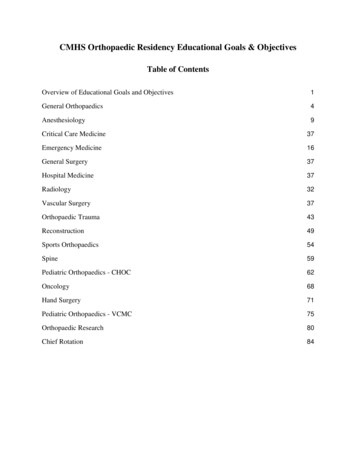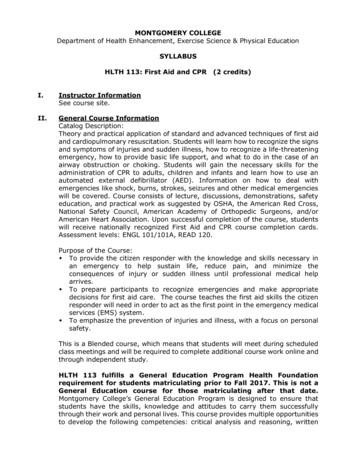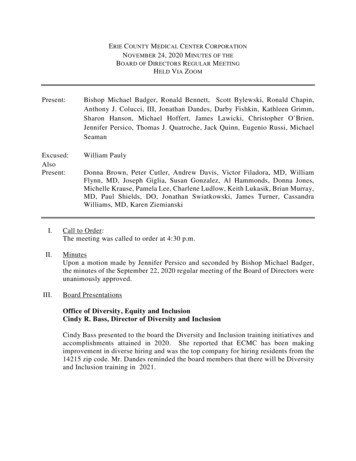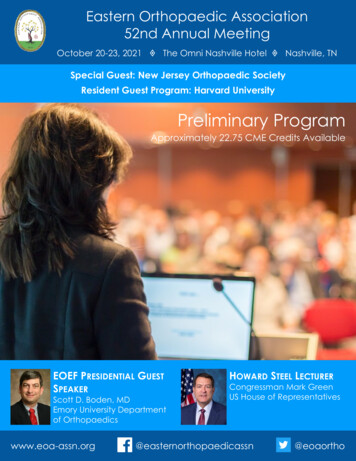
Transcription
Rothman Orthopaedic Specialty HospitalCommunity Health Needs Assessment Implementation PlanExecutive StatementCommunity Benefit Acknowledgement:Thank you to the key community stakeholders in the Rothman Orthopaedic Specialty Hospitalcommunities who participated in the conversations, Community Health Need Assessmentinterviews, focus groups, and follow-up meetings.Thank you to the Rothman Orthopaedic Specialty Hospital administration, physicians, leaders,and employees who participated in interviews focus groups and follow-up meetings.Description of Rothman Orthopaedic Specialty HospitalOn July 1, 2016, Thomas Jefferson University (TJU), a Pennsylvania nonprofit organization thatis exempt from federal income taxation pursuant to Section 501(c)(3) of the Internal RevenueCode, acquired majority ownership (54%) of Rothman Orthopaedic Specialty Hospital (ROSH),a Pennsylvania for-profit hospital with physician ownership. ROSH strives to provide qualityand compassionate care for our patients, incomparable service to our physicians an empoweringworkplace for our employees, many of whom live in our community, and a commitment toengagement with our community, setting the standard for superior, patient-focused health care.ROSH is a 24-bed surgical hospital located in Bensalem, Pennsylvania. The 65,000 square-footfacility with six fully-equipped operating rooms with the latest medical instrumentation isequipped for joint replacements, orthopedic surgery, pain management, spine surgery, sportsmedicine, foot and ankle surgery, shoulder and elbow surgery, and hand and wrist procedures.Ancillary services include laboratory, imaging, MRI, pharmacy, and physical therapy. Inaddition to its musculoskeletal patients, ROSH offers outpatient CyberKnife treatments for selectmalignant and non-malignant tumors.ROSH is accredited by The Joint Commission for demonstrating compliance with The JointCommission’s national standards for health care quality and patient safety in hospitals. The JointCommission’s hospital regulations address important functions relating to the care of patients1
and the management of the hospital organization. The standards are developed in consultationwith patients, health care experts, providers, and measurement experts.ROSH employs approximately 140 employees who work with 35 physicians and serve more than1,500 inpatients and almost 3,800 outpatient visits annually.Rothman Orthopaedic Specialty Hospital has consistently been recognized by Healthgrades forexcellence and outstanding achievements. These include: Healthgrades America’s 100 Best Hospitals for Joint Replacement 2021-2022Healthgrades Joint Replacement Excellence 2013-2022Healthgrades Outstanding Patient Experience Award 2017-2021Healthgrades Patient Safety Excellence Award 2019-2021Description of the Community ServedROSH's Community Benefit (CB) areas are defined as the areas proximate to the hospital wheremore than half of patients reside. This includes communities in Bucks, Montgomery, andPhiladelphia counties that are aggregated into 6 geographically contiguous regions defined by zipcodes. For comparisons, the combined data for Bucks and Montgomery counties combined(Bucks/Mont) and Philadelphia County are provided. Two comparators are warranted due to thedisparate populations of Philadelphia and its suburbs.2
More than 1.2 million people live in ROSH’s CB area. This represents 40% of all residents ofBucks, Montgomery, and Philadelphia Counties combined. Lower NE/N Phila has a higherpercent of youth ages 0-17 and Lower Bucks West and Eastern Montco have a higher percentageof adults aged 65 than other CB areas, Bucks/Mont and the United States. Lower Bucks West isthe least racial/ethnic diverse, with 88% of the population identifying as non-Hispanic White.The highest proportion of Asian and Pacific Islanders live in Northeast Philadelphia (12%), andthe highest concentration of Black non-Hispanics (34%) live in Lower NE/N Philadelphia. Thehighest concentration of Hispanics reside in Lower NE/N Philadelphia (36%).3
Purpose of the Community Health Needs Assessment (CHNA)Ongoing, unprecedented increases in the demand for healthcare are challenging for communitiesand healthcare providers in this era of limited fiscal resources. Regulatory changes also haveresulted in new obligations. One of the mandates of the Health Care Reform Act is a CommunityHealth Needs Assessment. Starting in 2013, every three years tax-exempt hospitals must conductan assessment and implement strategies to address priority needs. The Health Reform Act spellsout requirements for the Community Health Needs Assessment. This assessment is central to anorganization’s community benefit/social accountability plan. By determining and examining theservice needs and gaps in a community, an organization can develop responses to address them.A Community Health Needs Assessment is a disciplined approach to collecting, analyzing, andusing data, including community input, to identify barriers to the health and well-being of itsresidents and communities, leading to the development of goals and targeted action plans toachieve those goals. The assessment findings can be linked to clinical decision-making withinhealth care systems as well as connected to community health improvement efforts. Theassessment engages health care providers and the broader community by providing a basis formaking informed decisions, with a strong emphasis on preventing illness and reducing healthdisparities.Specifically, the Patient Protection and Affordable Care Act (PPACA) mandated a new sectionin the IRS Code –Section 501(r) for hospitals to obtain/maintain 501(c)(3) status: Each hospital facility must conduct a community health needs assessment at least onceevery three taxable years and adopt an implementation strategy to meet the communityhealth needs identified through the assessmentThe community health needs assessment must take into account input from persons whorepresent the broad interests of the community served by the hospital facility, includingthose with special knowledge of or public health expertiseThe CHNA must be made widely available to the publicThe Department of Treasury and the IRS encourage cross-institution collaboration. To that end,the Healthcare Improvement Foundation, in partnership with the Hospital and Health System of4
Pennsylvania and the U.S. Department of Health and Human Services (Region 3) convened theregion’s hospitals in the Collaborative Opportunities to Advance Community Health (COACH)Project. COACH seeks to demonstrate the potential for significant population health impactthrough coordinated, collective action to establish effective systems for addressing the socialdeterminants of health.Four principles are guiding the development of a strategy for leveraging community benefitprograms to increase their influence:1.) Defining mutually agreed-on regional geographic boundaries to align bothcommunity benefit and accountable health community initiatives2.) Ensuring that community benefit activities use evidence to prioritize interventions3.) increasing the scale and effectiveness of community benefit investments by poolingsome resources4.) Establishing shared measurement and accountability for regional population healthimprovement.Roles and ResponsibilitiesTo undertake this mandate, ROSH formed a Community Benefit Committee. The committee isresponsible for overseeing and recommending policies and programs to enhance the health statusof communities served by the hospital based on the results of a community health needsassessment. The Community Benefit Committee are trustees, staff, physicians, nurses and otherclinicians. The Committee may also invite, as guests, various representatives of the communitiesserved by ROSH. ROSH Community Health leaders with support of the Community BenefitCommittee recommends using the following model to guide planning and programmatic efforts,and to explain to internal and external stakeholders the rationale for the Community Healthimplementation plan.5
Community Health Needs Assessment MethodsLiterature Review and Secondary Data SourcesIn preparation for the community health needs assessment more than 20 secondary data sourceswere reviewed. Public Health Management Corporation’s Household Health Survey was a majorsource for local area data.6
In addition, as a collaborative effort, ROSH and Jefferson Health – Northeast conducted focusgroups with 29 employee representatives of the community in 2 sessions. Focus group questionswere designed to elicit participants’ perceptions of the major health and social concerns of theneighborhood and larger community, their insights regarding barriers to accessing health andsocial services and improving lifestyles, their opinions about existing and/or potentialinterventions to address community health improvement, and their thoughts about what specificrecommendations ROSH and Jefferson Health – Northeast could do to improve the health of thecommunity.These questions were designed to gain insight about health needs and priorities, barriers toimproving community health, and the community assets and efforts already in place or beingplanned to address these issues and concerns.The top 5 priorities identified for Southeastern Pennsylvania were: Integration of healthcare and behavioral/mental healthcarePreventive screeningsobesitybehavioral/mental health for adultsPrimary careHealth and HealthcareIn the hospital’s 2019 CHNA, the following priority health needs within the scope of ROSHservices for the population of the ROSH CB areas: Substance Abuse, especially Opioid addiction stems from addiction to pain relieversTowards the goal of making a positive contribution to reducing the opioid addiction crisis in ourcommunity1. ROSH partnered with the Bensalem Community Response Unit to fund responders tosubstance-related 911 calls. The program pairs a paramedic or EMT with a CertifiedRecovery Specialist to provide recovery support, education, resources, and treatmentoptions.7
2. Internally, pharmacists, surgeons and anesthesia providers worked collaboratively toorder multi-modality pain relief solutions in lieu of opioids.3. Surgeons proactively set patient expectations to expect some pain and to seek reliefthrough non-opioid medications.4. Drug-take back days were also marketed to employees and patients through displays andrepeat e-mail campaigns.ROSH community benefit also included financial assistance for elective surgery to individuals inneed in our community.Community Health Implementation Plan and ImpactImpact of Covid-19The Covid-19 pandemic along with its ongoing variants continues to have a profound impact onhealth systems globally. Since 2020, health systems have faced diminished staff capacity, limitedresources, and growing pressure to focus on responding to acute Covid-19 community needs.Many in-person programs and services traditionally rendered by ROSH to mitigate communityhealth needs were suspended for extended periods of time and or were transitioned into virtualdelivery. Despite these recent challenges, ROSH’s efforts to address community needs havecontinued with the work adapting to correspond with state-sanctioned safety guidelines.The 2019 CHNA Community Health Implementation Plan (CHIP) identified the followingdomains as the most critical and within the ROSH scope of services:1.)2.)3.)Healthy Lifestyle Behaviors and Community EnvironmentChronic Disease ManagementAccess to CareSince the 2019 CHNA, ROSH has executed the following initiatives in efforts to providerelevant community health needs relief:1. Healthy Lifestyles Domain8
a. Decrease Substance Abusei.Engaged with PA Department of Public Health (DOH) & Univ. of PittsburghSchool of Pharmacy for a "Prescription Drug Monitoring Program (PDMP)Culture Change Assessment Report" to assess hospitals’ medical staffengagement and utilization of the PDMP program. These recommendationsguided leadership efforts to improve PDMP utilization toward the identificationof patients who may have an opioid use disorder.ii.PDMP Compliance1. 2019 - 140 compliant PDMP checks out of 3,314 5% compliance2. 2020 - 3,863 compliant PDMP checks out of 4,159 93% compliance3. 2021 - 4,359 compliant PDMP checks out of 4,672 93% complianceiii.Rothman Surgeons Consent for Opioids (contract between surgeon & patient)1. 2018 - 13 pages - approximately 260 images scanned for 5,103 patients 5% compliance2. 2019 - 42 pages - approximately 840 images scanned for 5,086 patients 17% compliance3. 2020 - 147 pages - approximately 2,940 images scanned for 4146patients 71% compliance4. 2021 - 177 pages - approximately 3,540 images scanned for 4549patients 78% complianceiv.Advertise internally drug take-back days & local locationsv.2/27/2020 25K grant to Bensalem EMS to fund the placement of CertifiedRecovery Specialist with EMS personnel.vi.Stock two nasal spray Narcan in AED cabinet in Lobby for walk-in assistancevii.Narcan is also available in all Pyxis medstations for nursing additional stock inPharmacyviii.Medical staff active push towards multi-modal pain relief peri andpostoperatively to decrease the opportunity for addiction, especially amongstopioid naïve patients.b. Promote Physical Activityi.ROSH offers annual financial incentives to each employee (and spouse) whoparticipates in a Health Savings Account while achieving Vitality gold statusthrough logging of healthy activities that include biometrics.c. Social and Health Care Needs of Older Adults to Prevent Injuryi.Extensive promotion/amplification of Rothman orthopaedic surgeon articles,seminars, and talks through ROSH Social Media (Facebook exclusive).9
ii.Continued nurse education during hospitalization and at discharge regarding thereturn of unused narcotics2. ROSH Readmission rate is far below Pennsylvania’s average.Addressing all of the health needs present in a large community requires resources beyond whatany single hospital or social service agency can bring to bear. The Community Benefit Committeeof Rothman Orthopaedic Specialty Hospital is committed to fulfilling its mission as well asremaining financially viable so that it can continue its commitment to excellence in quality careand provide a wide range of community benefits. In addition, ROSH professionals will continueto collaborate with Jefferson Health colleagues to improve health status in conjunction with thehospital’s partnerships. ROSH will be participating in Jefferson Health’s 2022 CHNA & CHIPprocess. Best practices will be shared with the aim of enhancing infrastructure, stretchingresources, and incorporating knowledge about social determinants of health and health literacy tobetter the population's health and well-being.10
percent of youth ages 0-17 and Lower Bucks West and Eastern Montco have a higher percentage of adults aged 65 than other CB areas, Bucks/Mont and the United States. Lower Bucks West is the least racial/ethnic diverse, with 88% of the population identifying as non-Hispanic White.
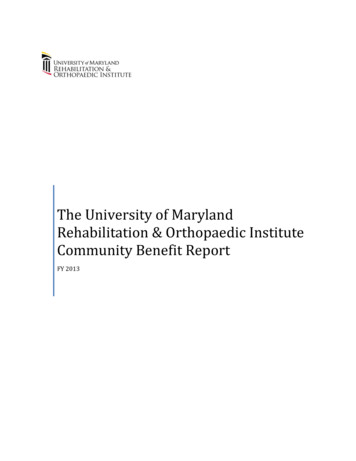
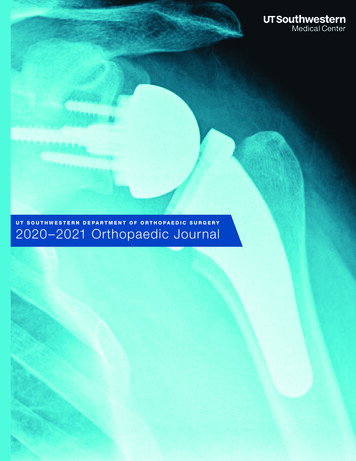
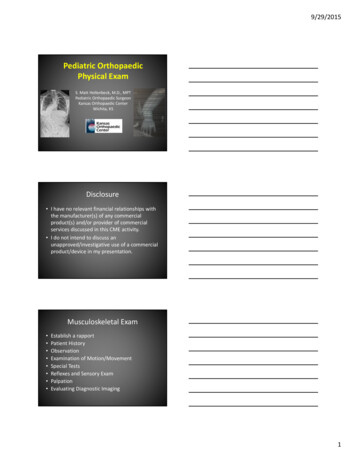



![[STUDENT ACHIEVEMENT FACTORS] - ed](/img/32/ed568687.jpg)
